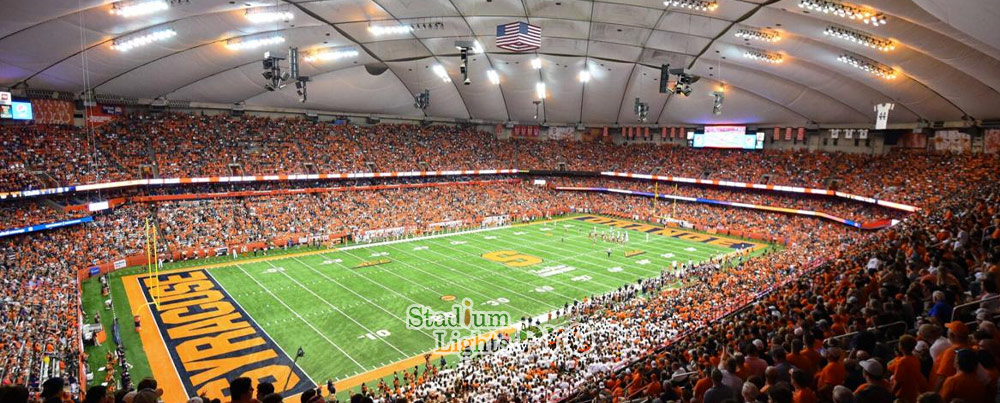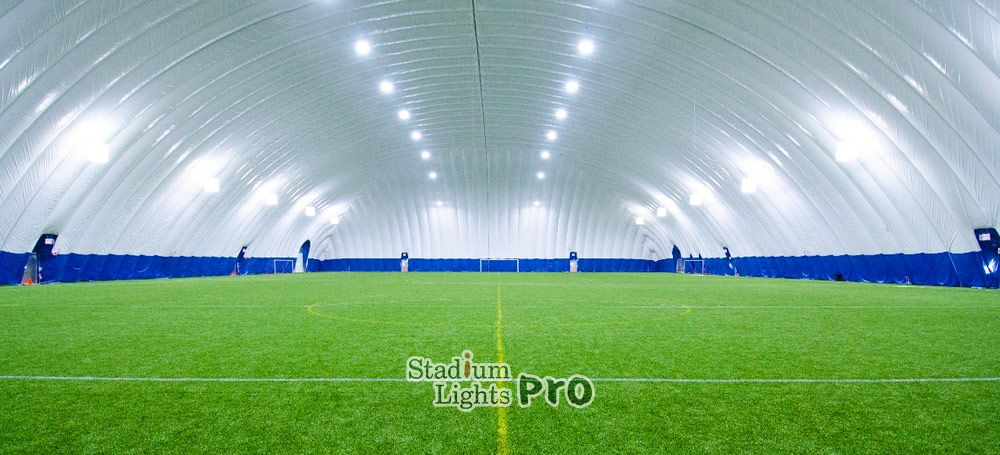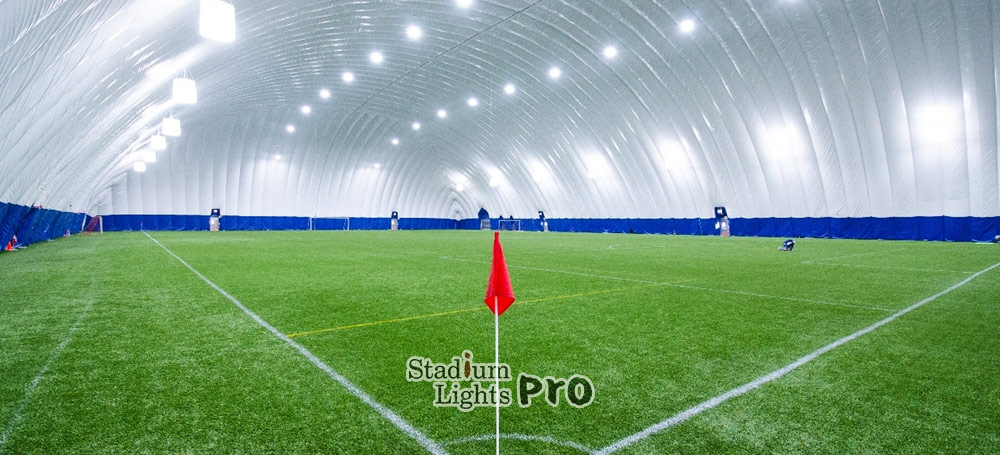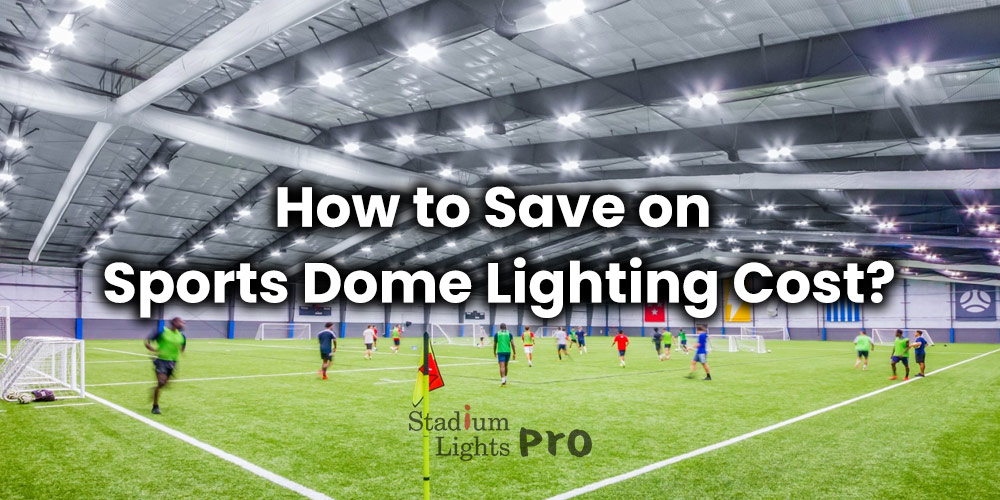Sports dome lighting is an essential element in creating a safe and enjoyable environment for sporting events. Proper lighting is necessary for players to see the field or court clearly, as well as for spectators to see the action taking place. In addition to improving the visibility and safety of the sports dome, proper lighting can also enhance the overall experience of attending a sporting event.
When it comes to installing sports dome lighting, cost is an essential consideration. The cost of sports dome lighting can vary significantly depending on a variety of factors, such as the size of the dome, the type of lighting used, and the required intensity of the lighting. It is recommended for sports dome owners and operators to carefully evaluate these factors and weigh the costs and benefits of different lighting options in order to make an informed decision.
Table of Contents
ToggleHow much do sports dome lights cost?

The cost of buying and installing sports dome lights will depend on several factors, including the size of the dome, the type of lighting used, and the complexity of the installation. Here is an example of how you might calculate the cost:
Determine the size of the dome
The size of the dome will determine the number of light fixtures you will need and the amount of electrical wiring required. For example, if the dome has a diameter of 100 feet, you might estimate that you will need 25 light fixtures spaced evenly around the perimeter.
Choose the type of lighting
The type of lighting you choose will affect the cost of the fixtures and bulbs. For example, LED lighting is generally more expensive upfront, but it is also more energy efficient and has a longer lifespan, which can save money in the long run.
Calculate the cost of the fixtures and bulbs
Once you know the number of fixtures and bulbs you need, you can calculate the cost by multiplying the number of fixtures by the cost per fixture, and the number of bulbs by the cost per bulb. For example, if each fixture costs $100 and each bulb costs $20, the total cost for 25 fixtures and bulbs would be $5,000.
Estimate the cost of installation
The cost of installation will depend on the complexity of the project and the hourly rate of the electrician or installer. To estimate the cost, you can multiply the estimated number of hours of labor by the hourly rate. For example, if the installer charges $50 per hour and you estimate that the project will take 20 hours, the cost of installation would be $1,000.
Total the sports dome lighting costs
To determine the total cost of buying and installing sports dome lights, you can add up the costs of the fixtures, bulbs, and installation. In this example, the total cost would be $6,000.
Keep in mind that these are just rough estimates and the actual cost of buying and installing sports dome lights could be higher or lower depending on your specific situation. It is always a good idea to get multiple quotes and compare prices before making a decision.
Running cost
How much does it cost to run the sports dome lights?
Calculate the wattage of the fixtures
The wattage of the fixtures indicates the amount of electricity they consume. You can find the wattage of the fixtures by looking at the label on the fixtures or in the manufacturer’s specifications. For example, if each fixture has a wattage of 100 watts, the total wattage of the 25 fixtures would be 2,500 watts.
Determine the number of hours the lights are used
The number of hours the lights are used will affect the amount of electricity they consume. For example, if the lights are used for 8 hours per day, you can estimate that they are used for 8 x 365 = 2,920 hours per year.
Calculate the cost of electricity
The cost of electricity will depend on the rate charged by your utility company. You can find the current rate by looking at your monthly bill or by contacting the company. For example, if the rate is $0.12 per kilowatt-hour, the cost to run the lights for one year would be 2,500 x $0.12 / 1,000 x 2,920 = $876.
Overall running costs
To determine the total cost of running the sports dome lights, you can add up the costs of electricity and any other expenses, such as maintenance or repairs. In this example, the total cost would be $876.
Factors that affect sports dome lighting cost
Size of the dome

The size of a sports dome can significantly impact the cost of lighting. In general, the larger the sports dome, the more lighting will be needed to adequately illuminate the space. This can increase the initial cost of the lighting installation, as well as the ongoing energy costs to run the lights.
For example, if a sports dome is 50,000 square feet, it will likely require more lighting than a sports dome that is 20,000 square feet. The larger sports dome will need more lighting fixtures, as well as more powerful fixtures to adequately illuminate the space. This can increase the initial cost of the lighting installation, as well as the ongoing energy costs to run the lights.
It is essential for sports dome owners and operators to carefully consider the size of the dome when choosing and installing lighting, in order to find the right balance between cost and lighting performance.
Type of lighting used
Different types of lighting, such as LED, HID, and fluorescent, can vary in cost. LED lighting is generally more expensive upfront, but it is also the most energy-efficient and has the longest lifespan, which can result in lower ongoing costs. HID lighting is typically less expensive upfront, but it is less energy-efficient and has a shorter lifespan, resulting in higher ongoing costs. Fluorescent lighting is generally less expensive than LED or HID lighting, but it is also less energy-efficient and has a shorter lifespan.
Required intensity of lighting
The intensity of lighting refers to the brightness or luminosity of the lights, which is measured in lumens. The higher the intensity of the lighting, the more expensive it will be to install and operate.
The required intensity of lighting will depend on the specific needs of the sporting event or activity taking place in the sports dome. For example, if the sports dome is being used for a high-level professional sporting event, the lighting may need to be much brighter and more intense than if the sports dome is being used for recreational activities.
Location of the sports dome
The location of the sports dome can affect the cost of lighting in a few ways.
Energy costs
If the sports dome is located in an area with higher energy costs, the ongoing energy costs to run the lights may be higher. This is because the cost of electricity can vary significantly from one location to another, and sports dome owners and operators will need to factor in these costs when evaluating the overall cost of lighting.
Weather conditions
If the sports dome is located in a region with harsh weather conditions, such as extreme temperatures or high winds, the lighting may need to be more robust and durable in order to withstand these conditions. This can increase the initial cost of the lighting installation, as well as the ongoing maintenance and replacement costs.
Available power supply
Power capacity
If the power supply at the sports dome is limited, the lighting system may need to be designed in a way that maximizes energy efficiency in order to keep energy costs low. For example, if the sports dome has a limited power supply, LED lighting may be a good choice because it is more energy-efficient than other types of lighting.
Upgrade costs
If the power supply at the sports dome is insufficient to support the desired lighting system, it may be necessary to upgrade the power supply in order to accommodate the lighting. This can increase the initial cost of the lighting installation.
Frequency of use
The frequency of use of the sports dome will also affect the cost of lighting. If the sports dome is used frequently, the lighting will need to be able to withstand more wear and tear and may need to be replaced more frequently, which can increase the ongoing costs for maintenance and replacement.
Wear and tear
If the sports dome is used frequently, the lighting will need to be able to withstand more wear and tear and may need to be replaced more frequently. This can increase the ongoing costs for maintenance and replacement.
Energy usage
The frequency of use of the sports dome can also affect energy usage and costs. If the sports dome is used frequently, the lights will be on for longer periods of time, which can increase energy usage and costs.
Sports dome owners and operators may consider the frequency of use of the sports dome when choosing and installing lighting, in order to find a solution that is durable and energy-efficient enough to meet the needs of the sports dome. By choosing lighting that is appropriate for the level of use, it is possible to minimize maintenance and replacement costs and keep energy usage and costs as low as possible.
Maintenance and repair costs
The costs for maintaining and repairing the sports dome lighting will depend on the type of lighting used, as well as the frequency of use and the location of the sports dome. LED lighting generally requires less maintenance and has a longer lifespan than other types of lighting, which can result in lower ongoing maintenance and repair costs.
Funding sources
The availability of funding sources, such as grants or sponsorships, can impact the cost of sports dome lighting in a few ways.
Initial installation costs
If funding is available, it may be possible to offset some of the costs of lighting installation. For example, a grant or sponsorship may provide funding for the purchase and installation of the lighting system, which can help to reduce the initial cost of the lighting.
Ongoing maintenance and repair costs
Funding sources may also be available to help cover the ongoing costs of maintaining and repairing the sports dome lighting. For example, a grant or sponsorship may provide funding for regular maintenance and repairs, which can help to reduce these costs over time.
Cost comparison: different types of sports dome lighting
LED lighting

LED lighting is generally the most expensive upfront, but it is also the most energy-efficient and has the longest lifespan. LED lights use less energy than other types of lighting and have a lifespan of up to 50,000 hours or more. This can result in lower ongoing energy costs and fewer replacements over time. The main drawbacks of LED lighting are the higher upfront cost and the fact that it may not be compatible with older lighting systems.
HID lighting
HID lighting is typically less expensive upfront than LED lighting, but it is less energy-efficient and has a shorter lifespan. HID lights use more energy than LED lights and have a lifespan of around 20,000 to 30,000 hours. This can result in higher ongoing energy costs and more frequent replacements. The main benefits of HID lighting are the lower upfront cost and the fact that it is compatible with most lighting systems.
Fluorescent lighting
Fluorescent lighting is generally less expensive than LED or HID lighting, but it is also less energy-efficient and has a shorter lifespan. Fluorescent lights use more energy than LED lights and have a lifespan of around 10,000 to 15,000 hours. This can result in higher energy costs and more frequent replacements. The main advantage of fluorescent lighting is the lower upfront cost, but it may not be the most cost-effective option in the long run due to the higher energy costs and shorter lifespan.
Cost-saving strategies for sports dome lighting
Sports dome owners and operators can save on lighting costs by implementing the following strategies:
Use energy-efficient lighting
One of the most effective ways to reduce lighting costs is to use energy-efficient bulbs and fixtures. LED lighting, for example, is extremely energy efficient and can last up to 120,000 hours, which is much longer than traditional incandescent bulbs.
Implement a lighting control system
A lighting control system allows you to manage the lighting in your sports dome more efficiently. For example, you can program the lights to turn off when the dome is not in use, or you can use sensors to detect when someone is present in the dome and adjust the lighting accordingly.
Perform regular maintenance
Regular maintenance can help extend the lifespan of your lighting and reduce the need for costly repairs. This can include cleaning the fixtures, replacing burnt-out bulbs, and checking for loose connections or other issues.
Use natural light
If your sports dome has windows or skylights, consider using natural light as much as possible to reduce your reliance on artificial lighting. This can save energy and money, and it can also create a more pleasant environment for athletes and spectators.
Turn off lights when not in use
It may seem like a small thing, but turning off the lights when they are not needed can make a significant difference in your energy costs. Consider installing switches or timers to automatically turn off the lights when the dome is not in use.
Use dimmer switches
Dimmer switches allow you to adjust the brightness of the lighting in your sports dome. This can be useful for creating different moods or atmospheres, and it can also help you save energy by reducing the amount of light you use when it is not needed.
Install occupancy sensors
Occupancy sensors detect when someone is present in the room and adjust the lighting accordingly. This can be an effective way to reduce energy consumption, as the lights will only be on when they are needed.
Use task lighting
Instead of using overhead lighting to illuminate the entire sports dome, consider using task lighting to focus on specific areas or activities. This can be more energy efficient and can also help create a more comfortable environment for athletes and spectators.
Invest in high-quality fixtures
While it may be tempting to go with the cheapest lighting options available, investing in high-quality fixtures can actually save you money in the long run. High-quality fixtures are more durable and reliable, so they are less likely to need repairs or replacements.
Conclusion
The cost of sports dome lighting is influenced by a variety of factors, including the size of the dome, the type of lighting used, the required intensity of the lighting, the location of the sports dome, the available power supply, the frequency of use, the maintenance and repair costs, and the availability of funding sources. LED lighting is generally the most energy-efficient and has the longest lifespan, but it is also the most expensive upfront. HID lighting is less expensive upfront, but it is less energy-efficient and has a shorter lifespan. Fluorescent lighting is the least expensive upfront, but it is also the least energy-efficient and has the shortest lifespan.
Thank you for considering us for your sports dome lighting needs. We offer a range of lighting solutions to suit your specific requirements and budget. If you would like to explore your options and get a sense of the costs involved, we would be happy to provide you with a free sports dome lighting design and discounted price quote on lights.
To request your free design and quote, please don’t hesitate to contact us. Our team of lighting experts will work with you to understand your needs and provide you with a customized solution that meets your specific requirements and budget.
We understand that cost is an essential consideration when it comes to sports dome lighting, and we are committed to helping you find the best possible solution at the most affordable price. By taking advantage of our free design and discounted price quote, you can get a better understanding of the costs involved and make an informed decision about the best lighting solution for your sports dome. So, please do not hesitate to reach out to us and we will be more than happy to assist you with your lighting needs.

